
We are celebrating 15 years — and counting — of stories that are deeply researched and deeply felt, that build a historical record of what the city has been.
We are celebrating 15 years — and counting — of stories that are deeply researched and deeply felt, that build a historical record of what the city has been.
Budgeting, however staid a topic it may seem, occupies a privileged place in public governance. It very well should. Accounting for and allocating funding to projects is one of the most important and powerful functions of government. But rather than embody the ideals of democracy, the budgeting process in New York City has historically been better known for closed door deals. For the past four years, however, a growing number of City Council members have put the power of allocating a chunk of discretionary funds directly in the hands of their constituents through a process called participatory budgeting. Residents of participating districts imagine, develop, propose, then vote on capital projects for implementation, physically shaping their communities as they see fit along the way.
The influence of participatory budgeting extends beyond just these built manifestations of people power. Perhaps more impressive is the process’s emphasis on inclusion of and outreach to traditionally marginalized and disenfranchised communities and the increased civic engagement that can result. Before voting in this year’s cycle gets underway next week, journalist John Surico tracks the city’s participatory budgeting process in its evolution from non-profit project to institutionalization within the Council Speaker’s office, learns of its achievements and frustrations, and contemplates the future of this exercise in direct democracy. –J.T.
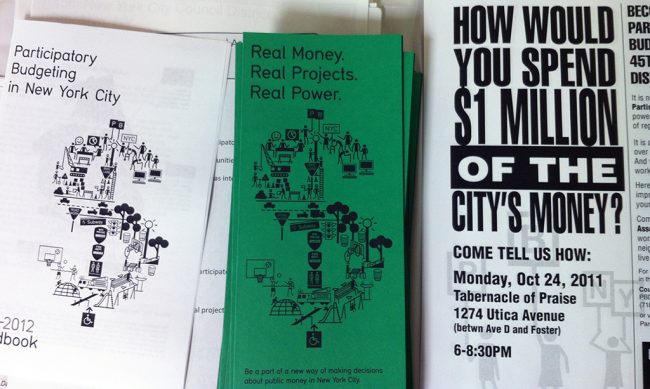
Photo via Daniel Latorre
For most of the people gathered inside a lecture room at Astoria’s Museum of the Moving Image — hailing from Flushing to the Bronx, Washington Heights to Sunset Park — the mid-March meeting was their first time.
They’d been given free pizza, and Aaron Jones, a field director for Community Voices Heard (CVH), directed a simple icebreaker: “Tell us who you are, what district you’re from, why you’re interested in participatory budgeting, and, if stranded on an island, what movie you’d bring.”
Movies choices varied, but everyone’s reason to be there was the same: outreach. These delegates, who had helped to develop potential projects now competing for funding, were training for the beginning of participatory budgeting voting in mid-April — a week when thousands of New Yorkers will decide how best to spend a chunk of their taxes.
Community Voices Heard leads get-out-the-vote efforts for participatory budgeting across the city. And with less than a month to go before voting, attendees were learning the best places to canvass (laundromats and libraries) and what to say to New Yorkers who usually don’t have a moment to talk. Ditch the salesperson schtick, “give them a sense that they can be part of something bigger than themselves,” and do not forget to ask the question that gets everyone, the question that remains at the heart of participatory budgeting:
“If you had a million dollars to fix your neighborhood, how would you spend it?”
Locations of participatory budgeting processes worldwide
In 1989, the residents of Porto Alegre, Brazil, were disgruntled with how their taxes were being spent. Challenges were met with political pet projects rather than effective solutions by, for, and of the people. So in an innovative reform package, social activists and municipal government officials changed the process and created participatory budgeting (shorthand: PB), which has since spread to over 1,500 municipalities worldwide.
In participatory budgeting, elected representatives cede the decision of how to spend a portion of existing funds to their constituents — one of a few examples of direct democracy in American republicanism. And it’s catching on: cities like Cambridge, Massachusetts, and Vallejo, California, have signed on, while Buffalo, New York, and Hartford, Connecticut, are seriously considering it. Chicago, which started PB in 2009, now has 20 participating aldermen, with upwards of $20 million going toward participatory budgeting. Four years into PB in New York, the number of participating council members has already grown from four to 24, out of a total of 51.
With nearly 17,000 New Yorkers voting in their districts last year, the city’s PB process now ranks as the largest in the country. Although the pot is small compared to the total City budget — $75 billion in the 2014-2015 cycle — the expenditure of at least $25 million of New Yorkers’ tax dollars is now decided largely by New Yorkers, not their elected representatives.
In New York’s annual budget cycle, all City council members receive a certain amount of discretionary funds to distribute to non-profit social service providers in their district. A system instituted last May by current Council Speaker Melissa Mark-Viverito aims to remove the politics that have historically marred this distribution by establishing a base payment to every council member and using need-based formulas (determined by district-level poverty rates, for example) to allocate additional funds. Council members can then choose whether or not to implement PB in their district with these funds, and how much to allocate to it (the minimum contribution is $1 million).
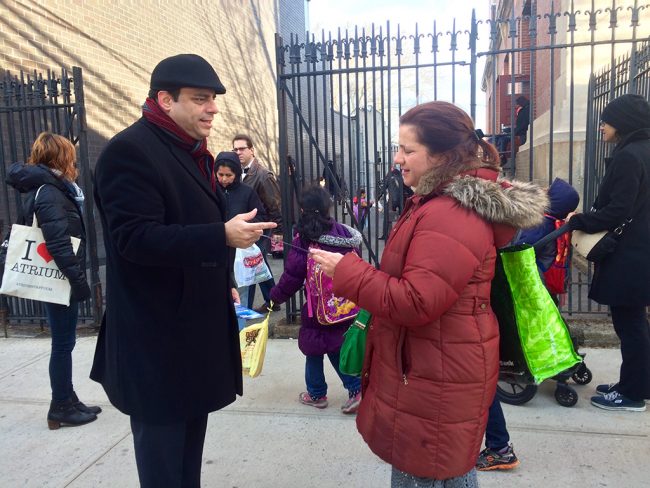
Costa Constantinides on participatory budgeting outreach duty | Photo via Costa Constantinides
One of the last additions to the freshmen class of “Cycle 4,” or the fourth year of PB in New York, is Council Member Costa Constantinides. He represents one of the most ethnically diverse districts in the city, if not the world: District 22, which runs from the Queens waterfront of Astoria Heights to eastern Jackson Heights and includes speakers of over 150 different languages. This year, more than a seventh of his discretionary funds will go to participatory budgeting.
Last September, his office kicked off the process with four town hall assemblies to gather ideas for potential projects from any interested resident. Then in November, close to 100 residents volunteered as delegates and, after orientation, were appointed to committees on issues most relevant to this residential, family-heavy area: public schools; parks and recreation; public housing; and streets, sidewalks, and transportation.
The delegates function in part as ambassadors, traveling across the district to learn what people want in their neighborhoods. Native Astorian Romina Enea, 25, is one of those delegates. She had always been interested in her community’s development but unsure how to get involved. PB made that easy for her after she heard about it through a local blog.
Following committee formation, delegates like Enea spend a few months forming proposals and establishing relationships with relevant City agencies to determine price tags and practicality. This is the only step in the process where officials exercise oversight over proposals. Enea said her parks and recreation committee’s contact with the Parks Department proved to be a reality check. Multilateral projects can be quickly dismissed by unilateral decisions. “We wanted to create things like a track or a dog run,” Enea said. “But it was like, ‘You can’t have a track at this park, because we already had one, and we got rid of it. But you can have this dog run — that’s fine.’”
District 22’s first-ever participatory budgeting process garnered 250 proposals in December. By February, after committee deliberations and City agency reviews, only 17 had been greenlit for voting.
“The most conflict in the PB process is with resistant agencies, or too many agencies,” said CUNY administrator Robert Nelson, 65, a four-year member of the transit committee in Council Member Brad Lander’s District 39 (Cobble Hill to Kensington, Brooklyn). Some projects find themselves at the intersection of several governmental bodies, which can make the completion process a dizzying deterrent.
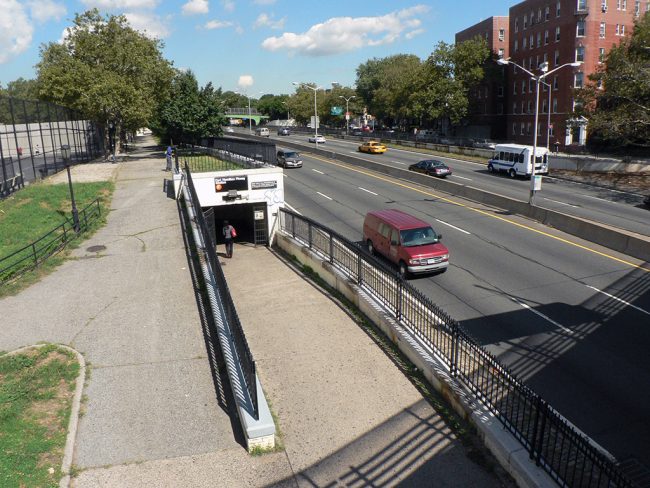
Fort Hamilton Parkway F/G subway station | Photo via Ian Westcott
Take, for example, the F/G subway stop at Fort Hamilton Parkway. “We wanted to renovate the entrance to the subway station,” Nelson said. “But the stairs and path to the entrance are run by the Parks Department, the sidewalk below is the City’s Department of Transportation, the subway entrance itself is the MTA, and the adjacent roads below the subway are the state’s Department of Transportation.” (The proposal, in the end, did not receive enough votes to be implemented, but Councilman Lander’s office voluntarily sought maintenance afterward.)
Participatory budgeting in New York is limited to capital funds, so projects can only improve upon something built already or build something entirely new — construction of a rooftop playground for a public school, accessibility improvements at a branch library, or the project Aaron Jones from CVH calls his favorite: outfitting a food truck in District 8, which covers East Harlem and the South Bronx, that drives around to demonstrate how to cook healthy meals (its operations are not funded by PB).
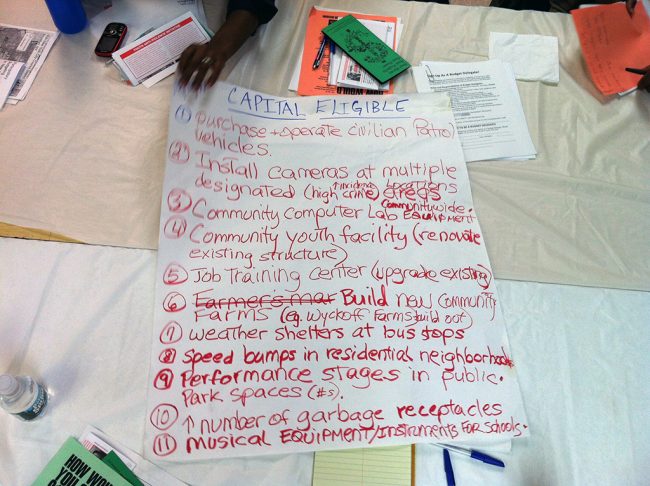
A list of eligible projects during a District 45 participatory budgeting meeting | Photo via Daniel Latorre
What is and isn’t eligible for funding through PB can be confusing. Certain maintenance needs mentioned at community workshops, such as fixing a crooked stop sign or a broken bench, fall outside the realm of PB and into that of expense funding. Expense funds, according to the City Council’s definition, cover “the operation of the city”: salaries, benefits, goods, supplies, equipment, contractual services, and telephone and fuel payments.
A PB process for “operating funds” does exist in other cities. The rules of the game are the same, but what can be funded is different. In California, one district in Vallejo voted last year to make repairing and repaving roads a priority for the Public Works department. Existing money for maintenance was then diverted to this specific goal — an idea that could respond to some New Yorkers’ desire to fix potholes before building anything new. But at this time, there are no intentions to expand PB in New York to include expense funding.
Lots under the Triborough Bridge in Astoria that could become a dog run funded by participatory budgeting
Another potential obstacle in the process can be the surprising cost of even small projects. A popular proposal in District 22 to convert a lot underneath the Triborough Bridge into a dog run seemed to require minimal funding. “You’d think that there’s already an unused lot with a fence. All it needs is a water fountain and some benches,” Enea explained. “But, in the end, that costs $500,000. So, the cost of things was a little disheartening to us at first.”
Despite the hurdles, the excitement Enea saw among her fellow budget delegates did not wane. “It was this realization that if this is what can be done, it’s something. And even if it’s small, it’s something we can put our names on and build for the community.”
Rod Townsend, a 47-year-old architect and budget delegate on the streets, sidewalks, and transportation committee in Enea’s district, agreed: the price itself can be “daunting,” but is matched by the willingness of delegates to prevail.
“You can’t know until you ask,” he said, referring to his committee’s proposal for a pedestrian plaza at the chaotic corner of Newtown and 30th Avenues. “We asked.”
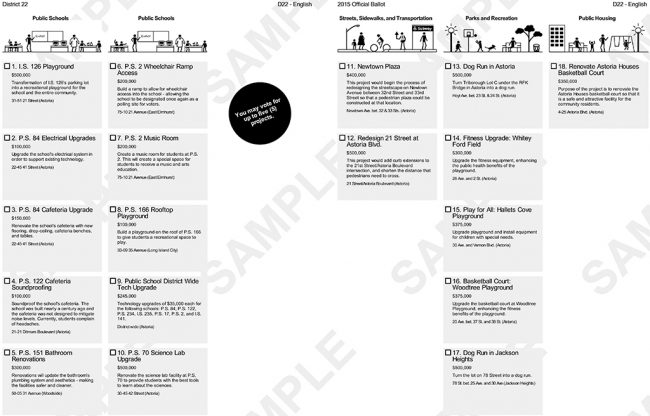
A sample ballot for District 22 PB voting this year | Image via New York City Council
Even if a proposal is too expensive or ineligible for PB funding, asking can lead a council member to fund a proposed project with other discretionary dollars. In other words, budgetary crowdsourcing can result.
“Being able to put out there, ‘We are going to pledge this funding to whatever you decide, now give us your ideas for what interests you,’ allows the public to bring to our attention maybe something that has not been considered,” Nick Widzowski, the legislative director for Councilman Constantinides, told me. “Or something that either us or local leaders have not typically thought about it.”
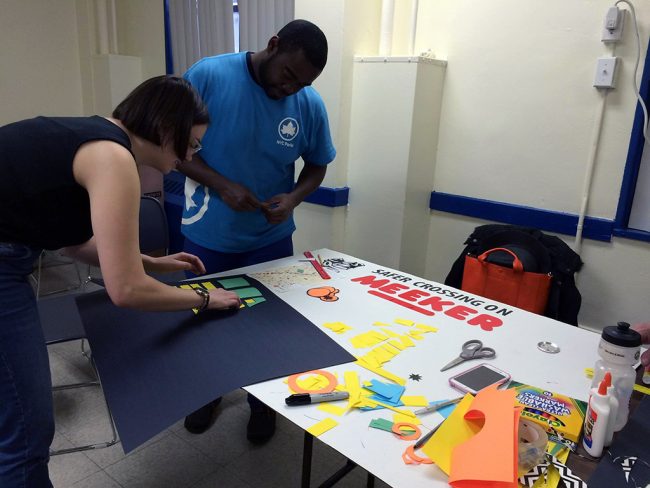
Poster making for a project in District 33 to make crossing Meeker Avenue safer | Photo courtesy of PBNYC
Once the process of eliminating ineligible or unfeasible projects is over, PB enters its “science fair” phase: from February to April, delegates host expos in school gyms and community centers where completed proposals are presented to the public. Residents are allowed to vote for five of these proposals during one week in April (dates vary by district), ballots are counted in May, and results announced in June. As many of the highest vote-getting projects as possible are funded with the discretionary funds allocated by the council member, so four $250,000 projects can win, or two costing $500,000.
These winning projects are not subject to the approval of the local council member, and at the next city-wide budget meeting, they automatically enter the City’s overall capital budget for implementation. In September, it starts all over again.
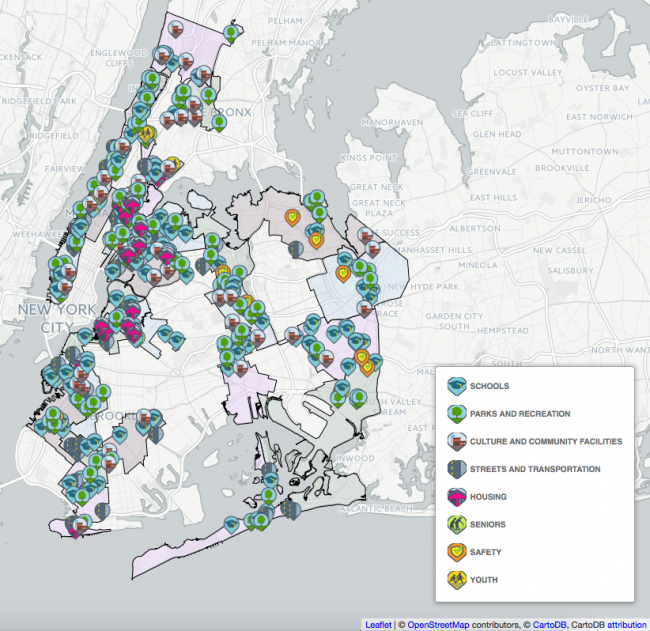
Click the map to access an interactive version showing all the PB projects in consideration this year and voting location for participating districts. | Map via New York City Council
There are 24 distinct participatory budgeting processes currently operating in New York, each customized to their district. Before delegates are chosen, a steering committee, usually made up of civic leaders of the respective community, lays out the rules and timelines in each district. Distinct community identities are apparent in both this structure and the proposals it ultimately produces. In 2013, 82 percent of District 8 voters in East Harlem and the South Bronx chose a project related to housing; in District 31 out in Far Rockaway, 89 percent went with a youth-based proposal.
“One of the strengths of PB is that it taps into local knowledge,” says David Beasley, the communications director for the Participatory Budgeting Project, a non-profit that helped establish the process in New York City in 2011. “The outputs of each project — whether it be computer labs in Councilman Jumaane Williams’ district, or lights for a high school field — they come from each community. They’re as widely varied as the communities themselves.”
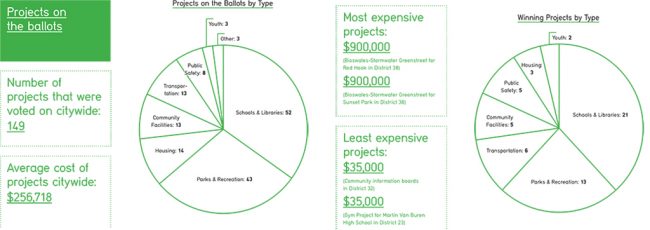
Analysis of Cycle 3 projects | Image courtesy of PBNYC
Participatory budgeting is also unique in how effectively it extends beyond traditional voting lines. According to research by the Urban Justice Center, two-thirds of voters last year were women (as compared to 57 percent in city elections), and 49 percent of voters had a household income below $50,000, significantly higher than their 38 percent share in citywide elections. 27 percent of voters were Latino, 39 percent Caucasian, and 24 percent African-American; in city elections, those numbers are closer to 14 percent for Latinos, 47 percent for Caucasians, and 32 percent for African-Americans. Sixty-two percent of total voters were people of color in Cycle 3.
Although overall participation rates are much lower for PB than your average political election, the process has succeeded in engaging traditionally marginalized groups and those often barred from voting. Contrary to almost all local, state, or nationwide elections, participatory budgeting allows and encourages undocumented residents to vote. It also extends the vote to individuals with criminal records and youth, through a minimum voting age of 14 or 16 years old depending on the district. All you need to show at the PB ballot box is proof of address, and if you don’t have a bill, passport, or Municipal ID, you can sign an affidavit affirming that you are a district resident.
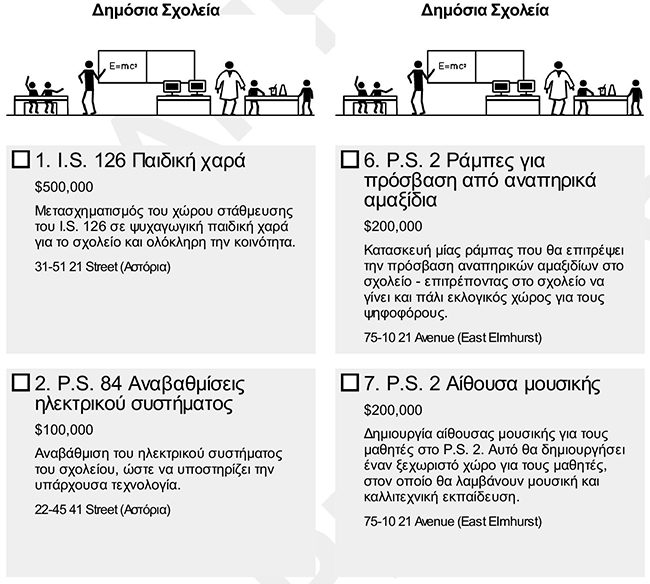
Detail from the District 22 sample ballot in Greek | Image via New York City Council
In the first year of participatory budgeting in New York, 19 percent of voters were born in a country other than the US. In Cycle 3, 36 percent were immigrants. The ballot itself is presented in eight different languages (and counting), and 20 percent of voters cast their vote in a non-English language.
Sixty-nine percent of voters have also lived in their neighborhood for eight or more years. That includes Anne Gough, a 55-year-old born, raised, and living in Flushing, which, along with parts of Douglaston and Bayside, constitutes District 20. This is the second year her district has taken to the PB polls and her second as an environment committee budget delegate.
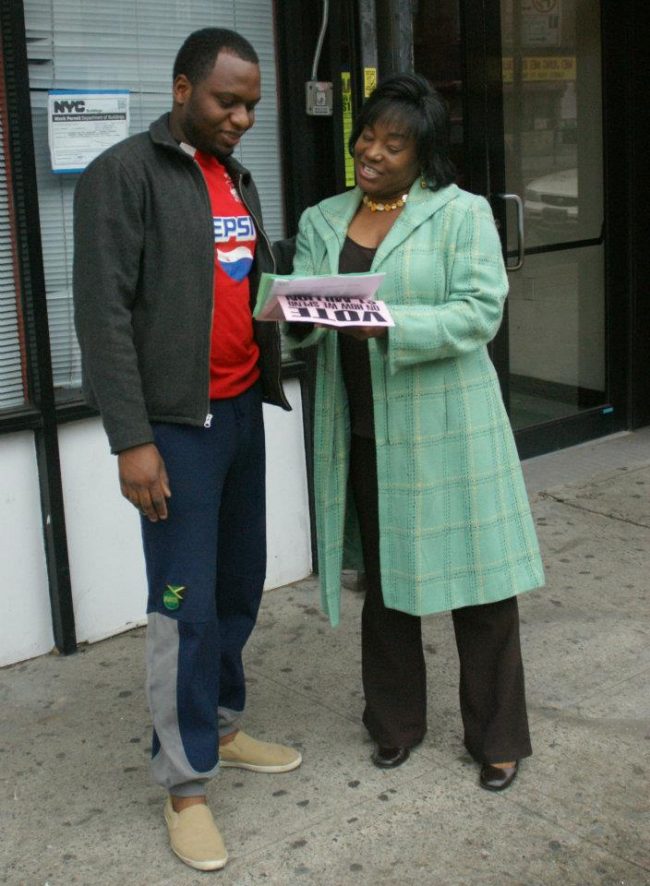
Outreach in District 45 | Photo courtesy of the Participatory Budgeting Project
Gough, who works in sports marketing, attended the Queens workshop to boost outreach in her neighborhood, which lost faith in PB after former Council Member Dan Halloran was convicted of corruption and bribery last year. She said Halloran’s office was “inept” at conducting the PB process, but new Council Member Paul Vallone has improved trust. After the first year of participatory budgeting, Gough also noticed that residents in her district demonstrated a willingness to become more civically engaged than before — a matter that is particularly important in Flushing, which has seen a major influx of Far Eastern immigrants who, Gough said, may not know how to engage the political system.
“Everyone who’s involved talks to their neighbors more, it seems,” she said. “On voting day, we have people speak Korean and Mandarin. They very much do want to get involved.”
And, surprisingly enough, balancing Flushing’s community interests with those of Douglaston and Bayside has not been difficult, says Gough. In the end, New Yorkers’ attention is not just limited to their own block: “For someone like myself, I travel all over. I don’t care; I go visit different parks, and I see a lot of different communities.”
Since he began, District 39’s Robert Nelson has witnessed participatory budgeting in New York transform from a non-profit project piloted by a handful of Council Members to what it is now: a streamlined institution within city government, overseen by Speaker Melissa Mark-Viverito herself.
The Speaker has been integral to participatory budgeting’s arrival, and flourishing, in New York. Along with Brad Lander, Jumaane Williams, and Eric Ulrich, she was one of the first four officials to adopt the process. The Speaker’s office now supports districts just getting started with staff to help coordinate the process. PB was a centerpiece of Mark-Viverito’s State of the City address in February, and the City Council’s website now prominently displays information about how to get involved in participatory budgeting. “This expanded process will give thousands of New Yorkers a hands-on role in making taxpayer dollars work for our communities,” she has said.
“With former Speaker Christine Quinn, it was different. She wasn’t as supportive of PB, and a bit controlling,” Nelson remarked. “With Melissa, more channels exist that didn’t before. Facilitators in my district have the ability to get in contact with her office whenever they want. … The process needed someone who was extremely interested.”
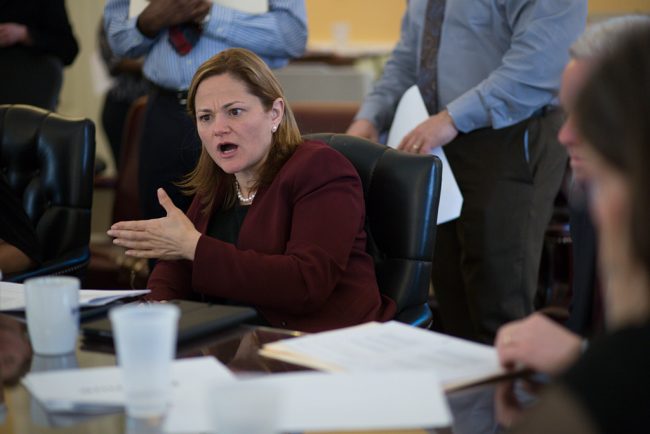
City Council Speaker Melissa Mark-Viverito during recent budget negotiations | Photo by William Alatriste, via New York City Council
Two years ago, Nelson was walking down Union Street in Gowanus and noticed something for the first time: trees. Dirt littered the sidewalks next to Callery pear saplings, freshly planted by the Parks Department. Then, it hit him: this was a PB project from Cycle 1. But how would anyone know?
“We try to raise awareness that this process is happening,” he said. “People are still surprised, don’t know about it, and sometimes don’t recognize it either. Like, ‘Oh, they put trees there; maybe the City put them in.’”
Most council members post updates on their websites so constituents can track the progress of participatory budgeting projects after they’ve passed. Council Member Lander’s shows that most of his district’s Cycle 1 (2012) projects — like new books and equipment for the Kensington public library, or two new bathrooms for P.S. 124 — were completed in 2013 or 2014, with a composting site the only exception. Four of the six Cycle 2 (2013) projects are underway, and two were finished last year. The average time it takes to finish a PB project, according to Jones, is just over a year.
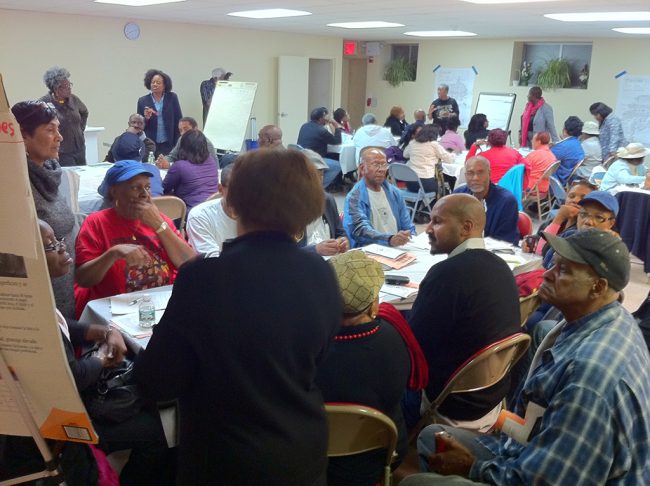
PB meeting underway in Flatbush, Brooklyn (District 45) | Photo via Daniel Latorre
One of the central concerns I heard from budget delegates was that the excitement of direct democracy could be quelled by the slow, groggy nature of New York City bureaucracy and the time it takes for these projects to actually be completed. But to Rod Townsend, participatory budgeting isn’t a “magic, wand-waving promise.” It can revolutionize the way we appropriate money in a metropolitan area, yes. But the process through which funded projects ultimately get implemented? Not so much. Yet that, to him, isn’t as important.
“I think people know things in New York City take time to go from concept to reality,” Townsend said. “But you can make a vote for money, change, and impact. That can really start a fire.”
The delegates I spoke with kept returning to that fire’s kindling, and the premise of the workshop in Queens that night: outreach. Romina Enea said her boyfriend and his friends had no idea what participatory budgeting was when she told them. She saw delegates drop out, and wished more people came out to neighborhood assemblies in her district. Townsend said the same. PB veteran Nelson, however, knows that growth and time are directly correlated.
At the end of every cycle, groups like Community Voices Heard, the Urban Justice Center, and the PB Project undertake research and evaluation to improve the process and make it more inclusive and efficient. The logistical obstacles that a new council member might face next year could be informed by lessons learned in another district in previous years. By Cycle 4, Nelson said, he was much better at spotting projects that had the best potential for approval, both from City agencies and voters.
“Running PB three times makes it easier to run the fourth time,” David Beasley said. “Whether that’s having pre-existing templates to adapt, or a community that already knows what the process is. … I think it’s really just a building of the community knowledge.”
Thus far every participating council member has returned for the subsequent year. No new council members are confirmed for Cycle 5 yet, but if the domino effect continues, 2016 will see more council members signing on, along with other cities across the country. That means more money, and, according to Beasley, more power from the grassroots. “We’re blown away that New York is gonna be spending more than $25 million in PB funding,” he told me. “Is $25 million a significant percentage of the City’s overall budget? No. Do we want to see it grow? Absolutely. Will it? We believe it will.”
“We have all sorts of new areas that I would love to see do PB,” he continued. “What if the Department of Education did PB? What would that look like?”
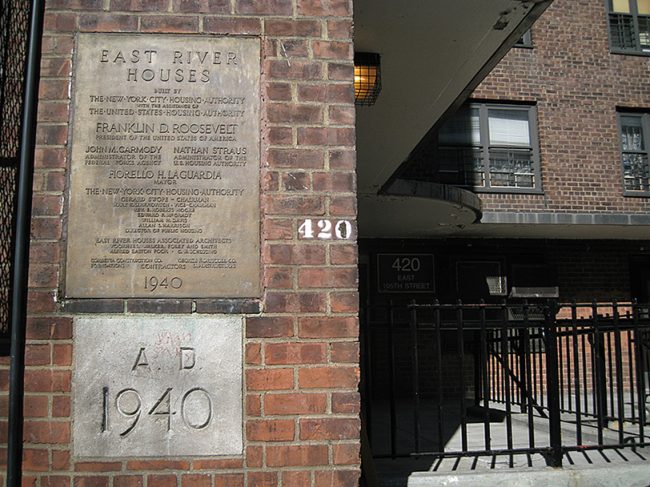
East River Houses | Photo via Cornerstones of NY
In Speaker Mark-Viverito’s State of the City speech this year, she announced that latest frontier: the New York City Housing Authority, the largest public housing system in the country. Projects for NYCHA developments do appear on some districts’ PB ballots; this year, those include new security cameras and doors at the East River Houses and a 300-square-foot garden at the Lexington Houses, both in East Harlem.
Nick Widzowski, of Council Member Constantinides’s office, said the forum held at NYCHA’s Astoria Houses was the most popular of their district’s four assemblies, with over 50 people coming out to voice ideas to improve their home. This is a constituency, he explained, that “[has] not been traditionally included in these kinds of things.” By applying PB to the internal NYCHA budget, Mark-Viverito hopes to “give NYCHA residents themselves a voice in how public money is spent at their developments.” A spokesperson from the Speaker’s office said this process will start in Cycle 5, though details on specific developments and projects are not yet available.
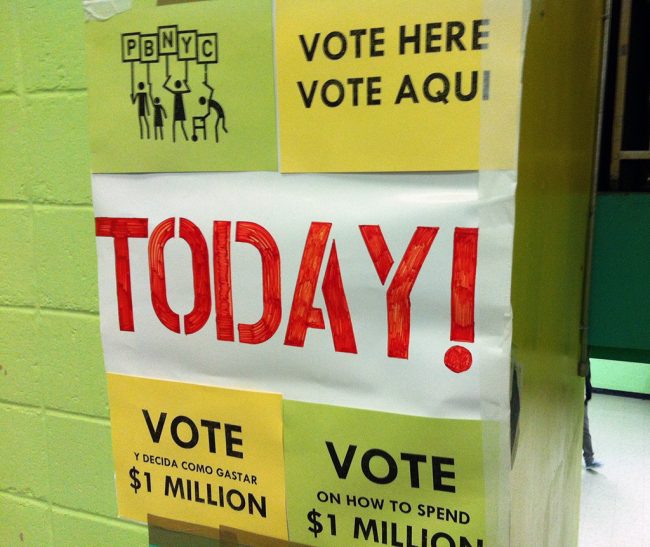
At the polls | Photo courtesy of the Participatory Budgeting Project
All of the residents I spoke to for this story said that they’d be returning to the process next cycle; the doldrums of municipal administration hadn’t discouraged them. Even if prices are high, and red tape is stretched, Anne Gough sees PB as a great way to stay involved in her community. Nelson is waiting for the day one of his committee’s proposals will be voted through. Townsend was excited to see turnout in the first year while Enea had high hopes for the next.
It’s this district-level patriotism that remains at the heart of it all — an excitement rarely seen in the annals of New York City community development and one that, to residents, actually produces results they can be proud of. Who knows what that means for the City’s overall budget process going forward. What people really care about, first and foremost, is being heard.
“Maybe it’ll affect turnout. Maybe it’ll have neighbors talking to each other more. They might not agree, but it’ll happen throughout the city,” Rod Townsend told me. “For so long, politicians were listening to people who yelled the loudest. Now, that’s us.”
The views expressed here are those of the authors only and do not reflect the position of The Architectural League of New York.